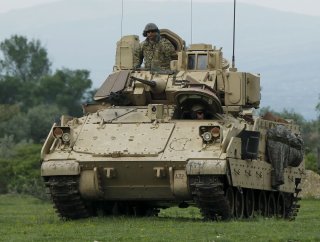The Army Wants to Use 3D Printing to Make Titanium-Armored Tanks and Vehicles
Titanium is stronger but lighter-weight than steel.
You could call it a contradiction in terms, or even a paradoxical blending of opposites—the U.S. Army is now designing a lightweight, highly lethal future armored tank that is easy to maneuver while being able to withstand dangerous enemy attacks and offering protection equal to or better than a 70-ton Abrams tank.
This goal lies at the center of the Army’s Next-Generation Combat Vehicle (NGCV), a family of new combat platforms now being developed by the service for future warfare. Its key goals are expeditionary, lightweight, fast, using artificial intelligence, potentially unmanned, extremely lethal and perpetually upgradeable. The effort involves building new infantry carriers, tanks and robotic vehicles networked together as part of an integrated tactical maneuver strategy.
Challenged by the Army’s emerging NGCV requirements, the Army Research Laboratory is now working to engineer new, lightweight yet survivable vehicle parts such as brackets, turret components, propulsion systems and weapons, using “additive manufacturing” or 3D printing technology. In particular, the effort includes the exploration of lightweight metals such as titanium, titanium alloys and hybrid ceramic tile/polymer-matrix composites.
“Titanium is lightweight and has a specific strength to weight ratio. Titanium is half the weight of other metals currently in use,” Dr. Brandon A. McWilliams, Materials Engineer, Lead for Metals Added Manufacturing, Army Research Lab, Combat Capabilities Development Command, Army Futures Command, told in an interview earlier this year, Aberdeen Proving Ground, Md. “With additive manufacturing, the costs can come down and make business sense.”
Certain elements of lower-cost titanium have already been in use for several armored vehicle applications such as up-armor for the Abrams tanks and the Commander’s Hatch in the Bradley Infantry Fighting Vehicle. However, this integration has been minimal and largely peripheral. Army engineers working on future combat vehicles are now calling for more titanium for large and vital elements in combat vehicles, in part because 3-D printing can deliver it in a more efficient, lower-cost fashion.
Interestingly, using more titanium for military vehicles is emphasized and anticipated in a 1997 essay, entitled “Low-Cost Titanium Armors for Combat Vehicles.” The essay, published in Journal of The Minerals, states “future-vehicle hull and turret will have to be manufactured using more ballistically efficient materials than rolled homogeneous steel armor. Low-cost titanium, with its good mechanical, ballistic, and corrosion properties and acceptable fabricability, offers the overall best alternative to achieving this objective.”
This was published years before “additive manufacturing” existed. Unlike traditional or more standard manufacturing techniques, new combinations of materials can be explored, or even created, using computer modeling as the essential step prior to printing parts with 3-D printing.
“It can be like organic designs. The computer will design it, and that will help drive down the weight,” McWilliams added. “We know our vehicles need to be lighter; we want to be able to drive across bridges, put more munitions in the vehicle and carry more soldiers. These are big drivers for NGCV.”
With the right sensors to detect or knock out threats at farther ranges and lighter weight protection materials, future tanks and infantry carriers might be able to operate at much higher speeds.
Kris Osborn is the defense editor for the National Interest. Osborn previously served at the Pentagon as a Highly Qualified Expert with the Office of the Assistant Secretary of the Army—Acquisition, Logistics & Technology. Osborn has also worked as an anchor and on-air military specialist at national TV networks. He has appeared as a guest military expert on Fox News, MSNBC, The Military Channel, and The History Channel. He also has a Masters Degree in Comparative Literature from Columbia University.
Image: Reuters

